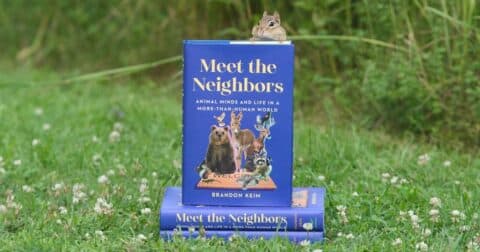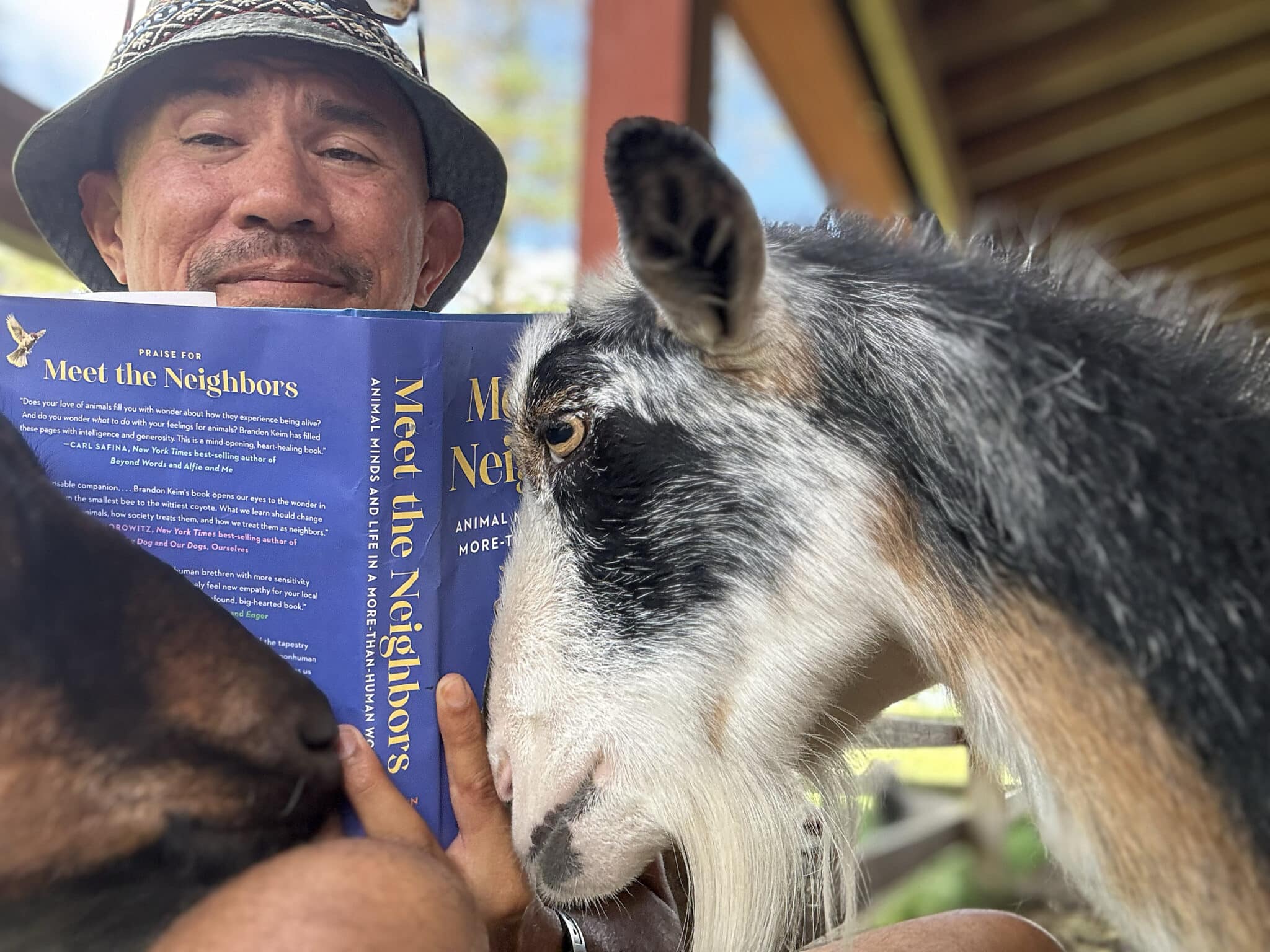News
GLP-1 Users Lose Weight, and Their Taste for Meat
Research•3 min read
Review
A big-hearted and heavily researched exploration of what it means to treat animals with respect.


Words by Dayton Martindale
In late 2016, a Canada goose was struck and killed by a car in an Atlanta parking lot. For the next three months, his mate would return to that site every day, sitting on the sidewalk in some mournful, mysterious vigil. We don’t know precisely what went on in the mind of this goose — what she felt for the one she lost. But, argues science and nature writer Brandon Keim, we shouldn’t be afraid to use words like grief, love and friendship. Indeed, he writes, a growing body of evidence paints many other animals as intelligent, emotional and social beings — “fellow persons who happen not to be human.”
This evidence makes up the first part of Keim’s new book, Meet the Neighbors: Animal Minds and Life in a More-Than-Human World. But for Keim, while the science of animal minds is interesting in and of itself, what’s most important is what this science implies: a moral revolution in our relationship with wild animals. Geese, raccoons and salamanders are not just populations to be managed, units of biodiversity or providers of ecosystem services: they are our neighbors, entitled to legal personhood, political representation and respect for their lives.
The traditional environmental movement has focused primarily on species conservation and overall ecosystem health, without much attention to individual animal welfare (with some exceptions). But a growing number of biologists, wildlife journalists and philosophers argue that we need a new way of thinking about wild animals. Sometimes this leads to conflict between conservationists and animal rights advocates, over the ethics of things like zoos and the killing of non-native species.
Keim, however, is less interested in conflict than in possibility; he doesn’t want to throw away the old values of biodiversity and ecosystem health, but instead supplement them with concern for individuals, and not just the endangered or charismatic. His book is accessible and big-hearted, written with humble curiosity about where these ideas might lead us. “Where animals fit into our ethics of nature…is an unfinished project,” he writes. “That task falls to us.”
Keim begins the book far from what we would normally call “the wild,” with a tour of a Maryland suburb “both dominated by humans and overflowing with animal life.” Rather than simply naming and identifying the myriad creatures he sees, he asks us to imagine their minds, what it’s like to be them.
Young male sparrows, we learn, form friendships with specific individuals, spending time with and living near their pals. Newly hatched ducklings seem to grasp the concepts of similar and different, passing tests that are difficult for seven-month-old humans. Turtles vocalize “to coordinate migrations and the care of their young.” Minnows have memory, frogs can count and garter snakes are self-aware, distinguishing their own scent from that of other snakes.
“Every single creature you encounter is a someone,” Keim writes, and the implications can enliven an afternoon stroll: is that bee in a good mood? Is that cottontail enjoying her grassy meal? Those swans on the lake might even be “voting” — research shows that whooper swans will start honking before taking flight, and only depart when the honks reach a certain frequency.
Keim doesn’t just want us to look at wildlife differently, however; he wants to change how we act on both individual and institutional scales. This includes bringing other animals into political decision-making — “We the People ought to include animals as well.”
He lays out the influential approach of political philosophers Sue Donaldson and Will Kymlicka, authors of the 2011 book Zoopolis: A Political Theory of Animal Rights. In their framework, Keim explains, while only domesticated animals like dogs and chickens would receive full citizenship status, the sparrows and squirrels of suburbia should also “merit consideration and some degree of representation in society’s deliberations.” This would mean “killing [wild animals] for sport or convenience is unjust; so are the harms of pollution, vehicle collisions and climate change.”
If these ideas sound abstract or impossible, Keim stresses that this trust is hardly new. Many Indigenous traditions also emphasized mutual relations and responsibilities with other creatures, representing animals in treaties and decision-making. Taking a long view, Keim writes, “not having animals represented is the aberration.”
And that aberration may be changing: New York City, for instance, has a Mayor’s Office of Animal Welfare that advocates for both domesticated and wild creatures within city government, promoting Meatless Mondays, plant-based meals in hospitals and getting the city to stop killing geese in parks. More speculatively, Keim writes, we might one day see animal ombudspersons, state-funded animal rights lawyers, animal representatives on city councils or even a UN animal ambassador.
While Keim does not dwell on this, it’s worth noting that representing animals politically could transform our relationships with the captive animals in farms, labs and puppy mills, as well as those living freely. After all, farmed animals are also cognitively and emotionally complex, as are dogs and cats — if we should respect the diverse needs and interests of wild animals, we must also attend to domesticated minds. Keim himself extolls the virtues of rats, capable of mental time travel and acts of altruism — if we should protect them from rodenticide, as he argues, we should also protect the millions of rats held in research labs.

The rest of the book sketches out what an ethic of respect for wild animals might look like in practice. We meet Brad Gates and other wildlife controllers who treat rodents and racoons as more than mere “pests,” using nonlethal methods to promote coexistence. As Gates emphasizes, we should prioritize keeping wild animals out of people’s homes in the first place, preventing conflict before it begins. But raccoons can be difficult to outsmart: once he found a mother raccoon who had learned to operate an electronic garage door opener, using it to go look for food every night, then closing it back up before morning.
Later in the book, we tour Washington, D.C.’s City Wildlife Hospital, which cares for urban animals who may have been orphaned by a car, attacked by other animals or struck by a bicycle. Rather than focus only on endangered or threatened species, as some wildlife groups do, City Wildlife takes in a wide variety of animals, from wood ducks to squirrels and box turtles. Keim reflects on this difference of approach as he encounters two vulnerable baby hedgehogs on a busy path: “I needed help for two specific wild animals — not populations, not species, but beings trembling in my hands — and no conservation organization…could offer much help.” Indeed, at first glance City Wildlife’s efforts, which can only help a small number of animals a year, might seem a distraction from more substantive conservation measures.
But, according to Keim and some of the experts he interviews, these different ways of looking at animals — as species to preserve, and as individuals to respect — can feed into each other. People who learn to care for a particular pigeon might come to appreciate all avian life in a new way; as Keim asks, “is a society that doesn’t see a lone mallard as deserving of care really going to protect much biodiversity, either?”
These initiatives are a promising precedent when it comes to caring for urban and suburban wildlife, but debates can be more contentious when it comes to wilder areas. For instance, wildlife management in the United States is largely funded by hunting, much to the chagrin of animal advocates. Keim pushes for a new paradigm not dependent on killing. But, as he documents, anti-hunting measures often inspire fierce backlash.
Keim also challenges the dominant approach to non-native species, which is to treat them as invaders and remove them, often lethally. Here, too, Keim insists that we should not lose sight of animals as individuals, and suggests that not all invaders are bad for the ecosystem.
Perhaps the book’s most provocative discussion comes in the final chapter, when Keim considers not just the good in wild animal lives — but the bad. Drawing on the work of ethicist Oscar Horta, Keim explores the possibility that most wild animals are in fact quite miserable: they starve, suffer disease, get eaten and the vast majority don’t live to reproduce. This bleak view, if true, yields distressing implications: destroying wild habitat might be for the best, claims philosopher Brian Tomasik, because it spares future animals from lives full of suffering.
Keim takes this argument seriously, but, inspired by ethicist Heather Browning, concludes that this emphasis on pain leaves out all the pleasure in wild animal lives. There may be joys inherent to “exploration, paying attention, learning, looking, moving, exercising agency,” and perhaps just simply existing — some birds, evidence suggests, enjoy singing for its own sake. Indeed, a major takeaway of Keim’s book is that animal minds are full and rich, containing more than just pain.
While we’d need further research to know whether pain or pleasure prevails, Keim allows, these thorny debates shouldn’t stop us from acting in the here and now. He recounts an experience helping amphibians safely cross a road, reveling in “that moment of connection with a frog or a salamander.” The title of his book is meant seriously: these are our neighbors, not distant or alien but relations deserving of care. “Each one I can save is a flicker of light in this world, a grain of sand on the scales of life.”